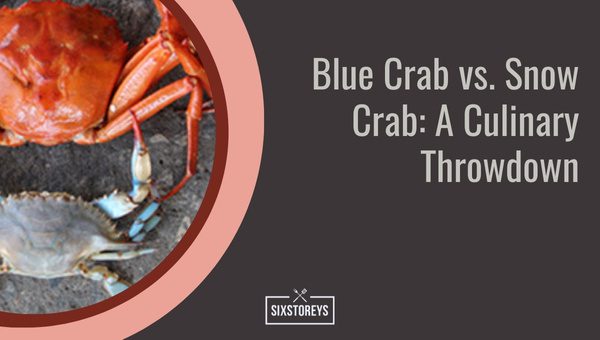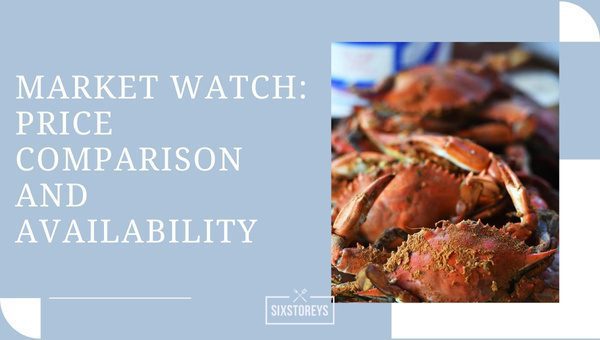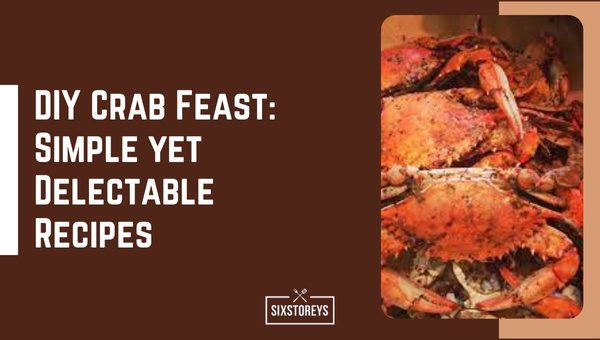Blue Crab vs. Snow Crab: Who Wins the Taste Test?
There's nothing quite as satisfying as cracking apart a fresh crab on a summer evening, savoring its rich, sweet meat. But the world of shellfish is simply teeming with variety. Which brings us to a beloved culinary debate that prevails among seafood lovers: "blue crab vs snow crab". These two crustaceans, while sharing some similarities, offer distinct flavors and characteristics that can transform your dining experience.
So, whether you're a seasoned seafood aficionado, or you're looking to try your hand at cooking these delicacies at home, understanding the unique features of these marine marvels will take your appreciation for seafood to whole new depths. Happy exploring!
Also Read: Dungeness Crab vs Snow Crab
Article Includes
Blue Crab vs. Snow Crab [A Culinary Throwdown]

When it comes to the great crustacean face-off, the two names that often pop up are the Blue Crab and the Snow Crab. Each brings to the table a unique blend of taste, texture, and culinary versatility.
In terms of taste, Blue Crabs are known for their sweet, tender meat, often described as having a 'buttery' flavor profile. Snow Crab meat, on the other hand, is slightly more delicate in flavor, with a snowy-white flesh that is both succulent and sweet.
As for texture, Blue Crabs provide a denser, meatier experience, especially prized in the claw meat. Snow Crab legs offer a more fibrous texture, which lends itself well to a variety of cooking styles.
Here's a quick comparative view of the two:
| Blue Crab | Snow Crab | |
|---|---|---|
| Taste | Sweet, buttery flavor | Delicate, sweet flavor |
| Texture | Denser, meaty texture | Fibrous texture |
| Culinary Uses | Steamed, in soups, crab cakes | Steamed, grilled, in chowders or bisques |
| Ease of eating | Requires effort to pick and clean | Eastern to crack open and eat |
The discussion doesn't stop at taste and texture, though. Each crab has its own set of unique qualities that can make it a more appealing choice, depending on your personal culinary preferences. Whether you're a novice or an old-hand at shellfish dining, this match-up will have you weighing your options on your next trip to the seafood market. In the end, isn't food all about exploring and enjoying a world of different flavors?
Demystifying the Blue Crab: Diving into the Facts
Originating from the Atlantic Ocean, the blue crab has sought a reputable name for itself in the seafood industry, present abundantly from New England to Argentina. The unique color palette, from which it derives its name, sets this marine creature apart from its kin. When you encounter it in the wild, you may admire its signature brilliant blue claws, contrasting strongly against the dull, mottled shell.
Once the blue crab sheds or molts, its soft shell becomes a culinary sensation. Representing the epitome of summer in places like Maryland, blue crab-centric dishes spiral the community into a seafood frenzy. Be it steamed and spiced in Old Bay seasoning, or served as lump meat in the notorious Maryland crab cakes, the blue crab's tender, sweet meat has a flavor you will not forget.
Unveiling the Snow Crab: All You Need to Know
On the flip side of the blue crab vs snow crab debate, you have the snow crab. With origins tracing back to the icy cold waters of the northern Pacific and Atlantic Oceans, snow crabs often compete with the infamous king crab for the spotlight.
Known scientifically as Chionoecetes, a Greek term translating to "snow dweller", snow crabs surely live up to their name. Despite lugging a weight less than blue crabs, snow crabs show off a legs-span that can stretch over 5 feet. These long, spindly legs are where you'll find the sweet, delicate meat that has made them a much sought-after luxury in seafood markets.
In the kitchen, snow crabs fare well in a whole slew of preparations. From broiling with a side of melted garlic butter to incorporating in pasta or sushi, the refined, slightly salted flavor of snow crab meat can add an exotic touch to any dish.
Deciphering our contenders in the "blue crab vs snow crab" debate provides us valuable insights into their unique attributes and culinary potential. Yet, the true victor materializes only after comparison of their taste, texture, cost, and even the sustainability of their species. So let us plunge deeper into the realm of these magnificent sea creatures.
Battle in the Kitchen: Remarkable Differences in Taste and Texture

When it comes to savoring crab, taste and texture play a pivotal role. Here's a quick comparison to break down the differences between blue crab and snow crab.
Blue Crab
Blue crab is renowned for its sweet, succulent flavor with a hint of saltiness drawn from the marine environment it inhabits. It's an absolute delight for the taste buds, especially when simply steamed or incorporated into a rich, warming soup. As for the texture, the meat is exceptionally tender and also slightly flaky. The backfin meat, in particular, boasts a delicate texture, providing a delightful contrast to the more robust claw meat.
Snow Crab
Snow crab, on the other hand, offers a slightly more subtle flavor - sweet, but not as pronounced as its blue counterpart. However, its real charm lies in its texture. The meat from Snow crab is incredibly fibrous, almost string-like, yet maintains a pleasant firmness. This unique texture makes it a favorite in salads or sushi rolls where it can really shine.
Healthy and Hearty: Nutrition Breakdown of Blue Crab vs. Snow Crab
Switching gears, let's also consider pretty important factors - the nutritional values of these decapod crustaceans.
Blue Crab
A serving of blue crab offers a healthy dose of protein, essential minerals like *zinc and *vitamin B12*, and is quite low in fat. Blue crabs can be a wonderful addition to a balanced diet.
Here's a quick look at their nutritional breakdown per 3.5 oz (100g) serving :
| Nutrient | Value |
|---|---|
| Calories | 87 |
| Protein | 18g |
| Fat | 1g |
| Zinc | 2.3mg |
| Vitamin B12 | 8.7ug |
Snow Crab
Snow crab, too, is a protein powerhouse and is slightly lower in calories compared to blue crab. It's rich in Omega-3 fatty acids - which are great for heart health - and also offers a reasonable amount of vitamin C.
Here’s a brief nutritional breakdown per 3.5 oz (100g) serving :
| Nutrient | Value |
|---|---|
| Calories | 82 |
| Protein | 16g |
| Fat | 1g |
| Omega-3 fatty acids | 0.4g |
| Vitamin C | 6.5ug |
When thumbing through the nutritional profiles, it's clear that both blue crab and snow crab offer a nutritious choice for seafood lovers. Be it the high protein content or the vitamins and minerals they pack, these crustaceans are undoubtedly healthful additions to your diet.
Market Watch: Price Comparison and Availability

Both the blue crab and snow crab promise mouth-watering culinary delights. However, let's address a significant deciding factor that often comes into play - cost.
Blue Crab Pricing
Blue crabs are generally known to be more affordable, especially in areas where they are native. For instance, if you find yourself in the Chesapeake Bay region, which has harbored these prized creatures for centuries, prices go as low as $20 to $50 per dozen.
Snow Crab Pricing
On the other hand, snow crabs are a luxurious indulgence, often commanding steep prices in the market. Hailing from the chilly seas of Alaska and Canada, these crabs sell for anywhere between $20 to $30 per pound.
Diving into the realm of availability, blue crabs are mostly seen in warm months, whereas snow crabs, true to their name, hit the market in winter.
Sustainable Seafood: Ethical Considerations
When reveling in the flavorful delicacy of these marine gems, it’s essential not only to consider the explosion of taste and texture on your palate but also sustainable practices and ethical considerations.
Blue Crab Sustainability
Blue crabs need close attention in terms of sustainability. While illegal harvesting has been an issue in places like the Chesapeake Bay, organizations like the Chesapeake Bay Program have launched conservation efforts to prevent the blue crab population from dwindling. Opt for vendors providing sustainably caught blue crabs.
Snow Crab Sustainability
Snow crab fisheries, on the other hand, are considerably sustainable and well-regulated, especially in areas like Alaska and the Barents Sea. Marine Stewardship Council (MSC) certified snow crabs are an excellent choice, ensuring you're supporting ethical and sustainable fishing practices.
DIY Crab Feast: Simple yet Delectable Recipes

Creating a crab feast at home is a fun and delicious venture, promising a true treat for your taste buds. Here, I'm sharing a couple of straightforward recipes for both the blue and snow crab.
Blue Crab Boil
A traditional blue crab boil is one of the simplest, yet most satisfying, crab dishes you can create. Here's what you'll need:
- 12 live blue crabs
- 1/2 cup Old Bay Seasoning or crab boil spice
- 2 sliced lemons
- A large pot with a lid
First, bring a couple of quarts of water, seasoned with the spice mix and lemons, to a rolling boil. Once it's bubbling, add in your live blue crabs, cover the pot, and let them cook for about 20 minutes, or until the shells turn bright red.
Snow Crab Bake
The sweet, delicate flavor of the snow crab comes to life in a classic baked snow crab legs dish. Here are the ingredients you'll require:
- 2 lbs snow crab legs
- 1/2 cup melted butter
- 2 cloves of minced garlic
- A baking sheet
Preheat your oven to 375°F. Arrange the crab legs on a baking sheet, then drizzle the melted butter and garlic over them. Bake for 15-20 minutes, or until they're heated through and nicely golden.
Both these recipes are pretty straightforward and promise a fun and delightful crab feast at the comfort of your home.
Also Read: Best Side Dishes to Serve With Crab Cakes
The King of Crabs: Making the Call between Blue Crab and Snow Crab
Choosing the king between blue crab vs snow crab isn't a simple task, as the choice heavily relies on personal preference. From the robust, savory flavor of the blue crab, perfect for a spicy boil, to the gentle sweetness of the snow crab, ideal for simpler recipes - you really can't go wrong with either.
When you're choosing between the two, consider your taste preference and cooking style. If you love strong, savory flavors, go for the blue crab. But if delicate, sweet notes appeal more to you, opt for the snow crab.
Also, consider the price and availability based on your location. Remember, the "best" crab for you is the one that fits your taste, your budget, and your kitchen! Enjoy the culinary adventure, one crab at a time!
